The Importance of Preservatives in Personal Care Products
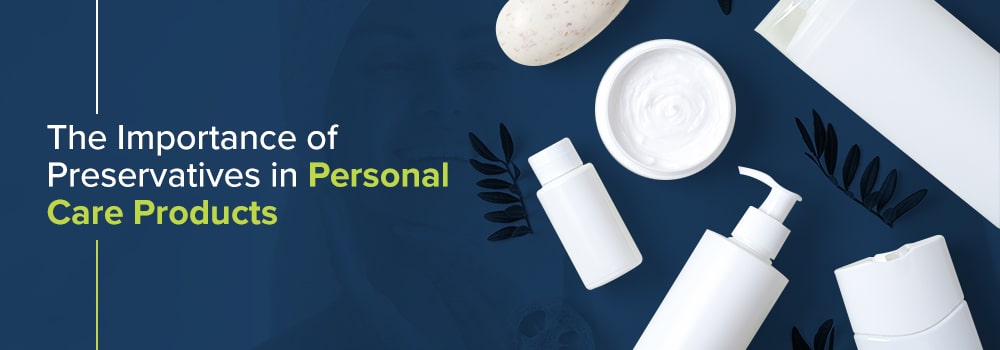
With evolving health trends, the term “preservatives” has taken on a negative connotation for some consumers, but preservatives are a healthy and normal part of everyday life. Humans have been finding ways to preserve food and other perishable products since ancient times. Today, just about any personal care products, including makeup, skin care products and other cosmetics, include a type of preservative in their ingredient list. Preservatives help cosmetics stay fresh and hygienic for consumers.
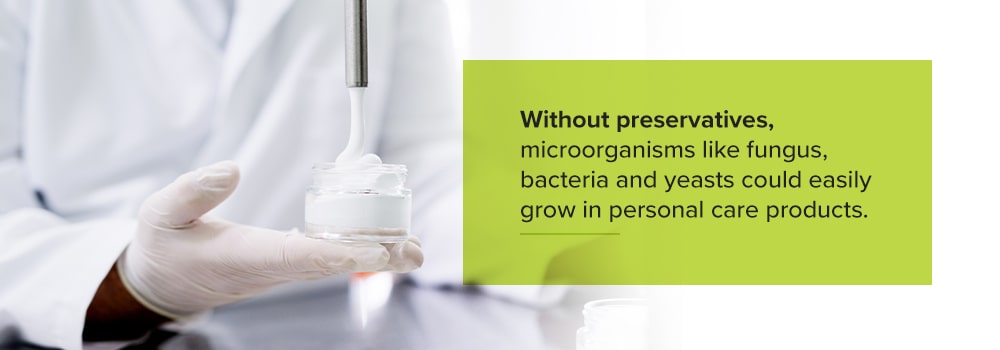
What Would Happen to Personal Care Products Without Preservatives?
To understand why preservatives are used in cosmetics, you need to understand what would happen to cosmetics if they didn’t contain preservatives. Personal care products can include a variety of ingredients. One thing nearly all these products have in common is that they contain ingredients that make them prone to microbial contamination. In other words, they’re perishable rather than shelf-stable.
Without preservatives, microorganisms like fungus, bacteria and yeasts could easily grow in personal care products. When microorganisms are able to grow in a product, the product can become moldy or otherwise unusable. It could also expose the consumer to possible illness.
Microbial contamination can occur in several ways. According to the Food and Drug Administration (FDA), some instances that can cause microorganisms like bacteria or fungi to get into cosmetics include when the product:
- Contains raw ingredients that were contaminated from the start.
- Is manufactured under poor conditions.
- Includes ingredients that encourage microorganism growth with no preservative to prevent it.
- Isn’t packaged adequately.
- Is stored or shipped in poor conditions.
- Is exposed to germs from the consumer, such as in the case of jars that users dip fingers into.
Even when taking every possible precaution during manufacturing to prevent contamination, microbial growth becomes inevitable as soon as a consumer opens the product. Personal care products are exposed to water in the bathroom and germs on a user’s body. Microbial growth can happen quickly, spoiling the product.
However microorganisms find their way into a product, you want that product to have properties that keep these microorganisms at bay rather than allow them to grow and thrive. Without preservatives, personal care products couldn’t stay on store shelves or on your vanity for long at all. Just like fresh food that quickly spoils, cosmetics that are free of preservatives may quickly change in consistency, color or smell or become covered in mold.
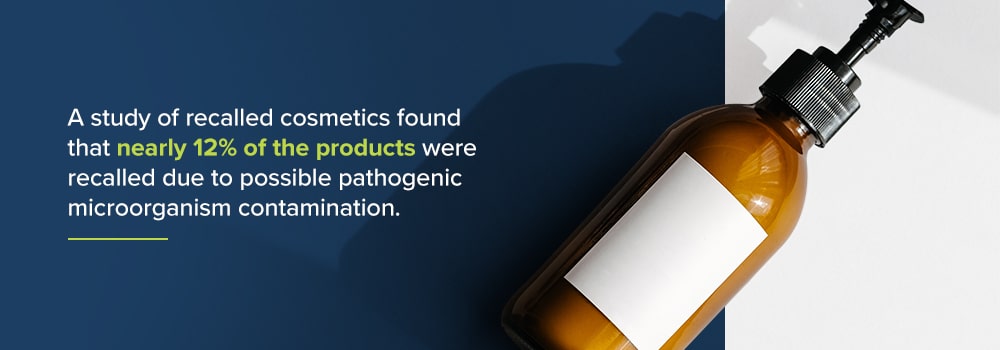
How Cosmetics Manufacturers Prevent Microbial Contamination
In addition to using preservatives, manufacturers should try to prevent microbial contamination at every step of the manufacturing process. A study of recalled cosmetics found that nearly 12% of the products were recalled due to possible pathogenic microorganism contamination. This is an issue manufacturers must take seriously, since it can ruin their products and make them harmful to consumers.
The guidelines from the Personal Care Products Council (PCPC) serve as the cosmetics industry’s benchmark for keeping microbial contamination down. These guidelines limit colony forming units (CFU) to 500 CFU per gram for any products intended for babies or for the eye zone and to 1000 CFU per gram for all other products.
Microbial contamination that occurs during the manufacturing process is known as primary contamination. If microbial contamination occurs during consumer use, this is known as secondary contamination. There are also two classifications of preservation. Steps taken to protect a product during manufacturing constitute primary preservation. Secondary preservation involves using chemical, physical or physicochemical means to protect the product further.
Both primary and secondary preservation are important steps. Safeguarding the product during manufacturing can help you create a quality product, but it won’t prevent microorganisms from growing once the product is opened. Preservatives can help a product remain shelf-stable for longer and stay fresh and safe while a consumer uses it.
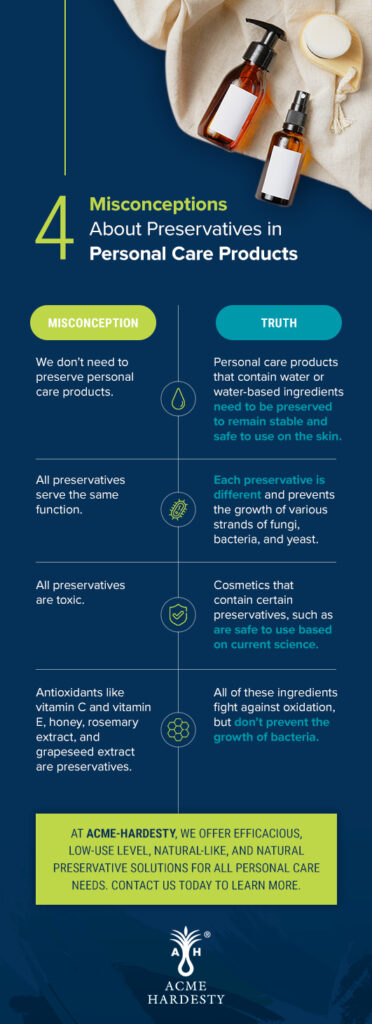
How to Choose Preservatives for Personal Care Products
Manufacturers can use a variety of preservatives in their cosmetics. There are several factors to consider in order to choose the best preservative for a personal care product, including:
- Efficacy: First, a preservative must have antimicrobial efficacy. In other words, it must be effective at actually preserving the product — preferably in small amounts. If this were the only requirement, manufacturers could use any sort of preservatives in skin care products and other personal care goods. However, there are many preserving agents that are effective but are considered unsuitable because they don’t meet the additional requirements below.
- Stability: Stability is an important consideration for all ingredients in a personal care product. Whether the cosmetic formulation is an emulsion, suspension, foam, aerosol or a combination of these mixtures, the preservative you use must not interfere with the product’s stability. Factors like a preservative’s solubility and partition in oil in water or water in oil emulsions and its volatility can influence how stable it will be. You also have to pay attention to the product’s pH and the temperature during use to ensure the preservative will remain stable under these conditions.
- Compatibility: A preservative must also be compatible with the rest of the product. For example, a preservative that causes an unpleasant odor or discoloration in a face cream would not be a good choice. Chemical compatibility is also crucial. You must note how a preservative will interact with other ingredients like solvents, surfactants, dyes or perfumes. In some cases, certain ingredients may have an antagonistic effect or may decrease a preservative’s efficacy, while others may have a synergistic effect on the preservative.
- Safety: Safety is a chief concern for all ingredients used in personal care products. Keeping products safe is a major reason why preservatives are used in skin care and other personal care products to begin with. Some preservatives may not be safe in and of themselves. Manufacturers must choose preservatives that are non-toxic or have low toxicity. Many preservatives are safe at low levels, but not at excessive levels. When this is the case, a preservative must be effective at low levels.
- Cost: Preservatives vary in price, and some manufacturers may be tempted to choose more affordable preservatives. Cost will always be a practical concern for companies, but cost should be of secondary concern after a preservative’s efficacy, stability, compatibility and safety. Keep in mind that cost will be tied to how much preservative you use in cosmetics, so some seemingly more expensive preservatives may be more cost-effective if they’re effective in smaller amounts.
In some countries, manufacturers must also limit their selections to preservatives that comply with the relevant laws. In Japan and in European Union countries, companies must stick to approved preservatives included in an official list. In the U.S., there are no legal requirements, but companies are expected to be aware of the existing scientific literature and responsibly choose safe and effective preservatives for their products.
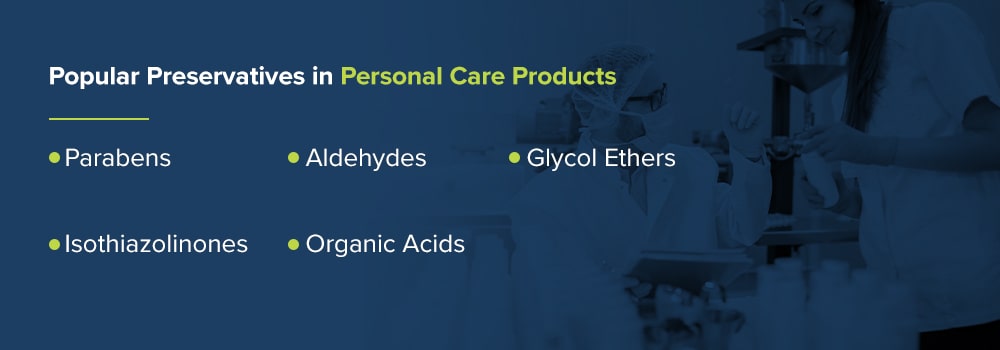
Popular Preservatives in Personal Care Products
Some of the most common preservatives used in cosmetics include parabens, isothiazolinones, aldehydes, organic acids and glycol ethers. A preservative’s suitability depends in part on the rest of your product formulation, but in many cases, these preservatives fit the bill. Let’s take a closer look at each of these options and what makes them useful preservatives in personal care products:
1. Parabens
Parabens are a family of chemicals that are widely used as preservatives in cosmetics. In fact, they’re the most popular preservative for personal care products on the market today. Parabens are derived from para-hydroxybenzoic acid (PHBA), which is naturally occurring in many types of produce. The most commonly used parabens include methyl paraben, butyl paraben, propyl paraben and ethyl paraben.
Some companies that pride themselves on health consciousness may be concerned about their consumers’ perception of parabens. Parabens have been the subject of some controversy, but the FDA confirms that they currently have no reason to consider parabens used in cosmetics as anything but safe and healthy. Parabens remain a popular preservative because they are effective in small amounts against a wide spectrum of fungi and bacteria, they are odorless and colorless, and they are non-irritating on most people’s skin.
2. Isothiazolinones
Isothiazolinones are a group of heterocyclic sulfur-containing compounds. These compounds are effective preservatives that can prevent bacterial and fungal growth. Included in this family of compounds are methylisothiazolinone (MI), methylchloroisothiazolinone (MCI), octylisothiazolinone (OIT) and benzisothiazolinone (BIT). Each of these compounds offers its own advantages. BIT, for example, is a good choice for long-term preservation. Sometimes, these compounds are used in combination. An MCI and MI combination can defend against an exceptionally wide spectrum of bacteria, fungi and algae.
While isothiazolinones are effective preservatives, they are not as popular as some other options on this list because they can irritate skin at high concentrations. For this reason, they are mainly used in rinse-off products instead of leave-on products. In the U.S., MI must remain at or under 100 parts per million (ppm) in both leave-on and wash-off cosmetics.
3. Aldehydes
Aldehydes are organic compounds that include a carbon atom sharing a double bond with an oxygen atom and a single bond with both a hydrogen atom and another atom or group of atoms. Aldehydes are derived from alcohols by removing the hydrogen from them. This class includes, among other compounds, formaldehyde and formaldehyde releasers. A popular formaldehyde releaser used in personal care products is DMDM hydantoin.
Also known as formaldehyde donors, these compounds slowly release small amounts of formaldehyde over a product’s shelf life, which effectively safeguards against many types of microbial growth. Though formaldehyde may sound like an unpleasant ingredient for cosmetics, people routinely consume small amounts of formaldehyde in a variety of foods. The amount of formaldehyde DMDM hydantoin releases in a personal care product is similar to what you would find in an apple or pear, so it’s perfectly safe.
4. Organic Acids
Organic acids are simply organic compounds with acidic properties. This includes benzoic acid, sodium benzoate, sorbic acid, potassium sorbate, levulinic acid and anisic acid. These acids can prevent fungal growth and some bacterial growth, which has prompted some personal care product brands to use them in place of more conventional preservatives. The term “organic” can be attractive to consumers looking for natural products. However, organic acids are often made synthetically, like other preservatives.
They also have some potential drawbacks compared to other preservatives. Their relatively low pH ceilings mean they’re often incompatible with the rest of a cosmetic formulation. Organic acids also require higher concentrations than some other preservatives to be effective. Despite these preservation downsides, organic acids can be helpful ingredients to include in some personal care products for other reasons. For example, fatty acids make great emollients and thickening agents, and they can work as a cleansing agent when combined with glycerine.
5. Glycol Ethers
Glycol ethers are a group of solvents that are common in a variety of products, including personal care products. Glycol ethers like caprylyl glycol and phenoxyethanol are popular glycol ethers used as preservatives in cosmetics. These solvents can help stabilize ingredients in a cosmetic formulation and can keep bacterial growth to a minimum to maintain freshness and potency.
Phenoxyethanol is an oily substance that is usually clear and is soluble in both oil and water. It is unaffected by light or air, which makes it an ideal choice as a preservative for many products, including ones stored in clear containers. Phenoxyethanol also pairs well with many other substances, including other preservatives, making it score well on the compatibility factor. Additionally, phenoxyethanol is effective in very small amounts.
What Are Natural Preservatives?
Many consumers are interested in labels like “all natural,” and some cosmetics brands may capitalize on this preference by advertising their products as only containing natural preservatives or even being preservative-free. But what does this mean exactly? Typically, these claims mean the formulation does not contain standard preservatives and instead includes natural ingredients that have some preserving properties. Some popular examples include:
- Antioxidants like vitamin C and vitamin E
- Honey
- Rosemary extract
- Grapeseed extract
These ingredients have some positive properties for personal care applications, and they offer some preserving properties. For example, antioxidants protect products against oxidation, which can lead to ingredient degradation. However, antioxidants cannot effectively prevent microbial contamination. When considering natural preservatives as a whole, issues like pH-dependency, volatility, strong odors and more make natural chemical substances less than ideal as preservatives in many cases.
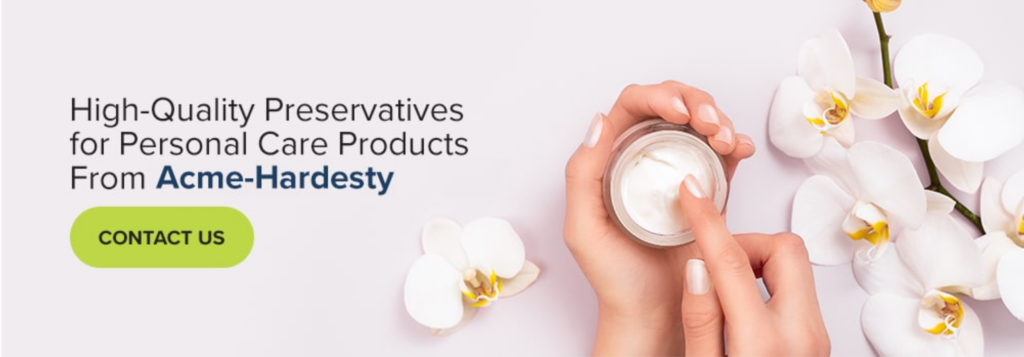
High-Quality Preservatives for Personal Care Products from Acme-Hardesty
Preservatives are an important part of any safe and effective personal care product. If you want to purchase preservatives online to use in your product formulations, Acme-Hardesty is a trusted source. Our long history and reputation for quality make us a leader in the industry, especially when it comes to raw preservatives for cosmetics, along with castor oils and palm derivatives.
Read more about the different preservatives we offer, compare prices online and select the amount you need. We make it easy to get the high-quality preservatives you need to keep your personal care products fresh and hygienic for consumers. If you have questions about cosmetics preservatives or you want to learn more about our preservatives and other products, contact us today.
